Dear All,
Little bits of trivia first: the Humming Birds have arrived and are feeding in the courtyard at the honey-water bottles. I managed to get a few photographs - even 1. one showing a bird in flight, 2. another one settling on the rail as it finishes hovering with its wings moving at 40 times per second, and 3. one looking up after having dipped into the honey hole at the base of the bottle. It would be about 6 cm long at the most. 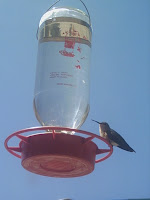
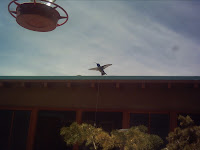
 The arrival of the humming birds coincides with the flowering of cactii, especially the cholla which you saw in a previous blog. The cholla are branched and have tight yellow flowers at the end of each stalk. The humming birds hover to feed from them. The cactus prickles are quite
The arrival of the humming birds coincides with the flowering of cactii, especially the cholla which you saw in a previous blog. The cholla are branched and have tight yellow flowers at the end of each stalk. The humming birds hover to feed from them. The cactus prickles are quite 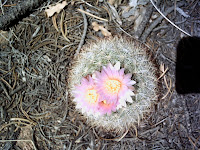 savage, I have discovered - they go right into your skin about a millimetre or two immediately upon contact, and there they stay until you pull the needle-like point out. I did not take long to learn to give cholla (and other cactus) a wide berth!
savage, I have discovered - they go right into your skin about a millimetre or two immediately upon contact, and there they stay until you pull the needle-like point out. I did not take long to learn to give cholla (and other cactus) a wide berth! The picture on the right shows a little 'pin-cushion' (my name) cactus in flower. These are all over the hills out here at present, flowering profusely. Quite delightful! I took this photo when I climbed 'The Needles' on my last desert day. 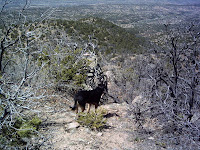 Obo came with me and I took a picture of him (on left) admiring the scenery during our descent. I did not 'invite' him, but as I walked out the front door, pack on back, he jumped up and joined me. As we climbed the needles he started to walk more slowly, making sure he was in the shade of bushes and lying down, panting, whenever he had a chance. So I tried out a snack on him - banana! He ate it! I shared one actually - a piece for him, a piece for me. Since I had two water bottles, I let him drink out of one; he was a bit wasteful, lapping at the opening, but looked very enthusiastic and grateful. Later - much later, after we descended to running water, he had half of my sandwich - vegemite, peanut-butter & celery - gobble, gobble! Then I ate my apple and tried a piece on him - crunch, crunch! Another piece went the same way, and then I gave him the core at the finish. Crunch, crunch - all gone! What a dog! He also took raisins with enthusiasm, although I rationed them carefully.
Obo came with me and I took a picture of him (on left) admiring the scenery during our descent. I did not 'invite' him, but as I walked out the front door, pack on back, he jumped up and joined me. As we climbed the needles he started to walk more slowly, making sure he was in the shade of bushes and lying down, panting, whenever he had a chance. So I tried out a snack on him - banana! He ate it! I shared one actually - a piece for him, a piece for me. Since I had two water bottles, I let him drink out of one; he was a bit wasteful, lapping at the opening, but looked very enthusiastic and grateful. Later - much later, after we descended to running water, he had half of my sandwich - vegemite, peanut-butter & celery - gobble, gobble! Then I ate my apple and tried a piece on him - crunch, crunch! Another piece went the same way, and then I gave him the core at the finish. Crunch, crunch - all gone! What a dog! He also took raisins with enthusiasm, although I rationed them carefully. TAOS
Last Friday (19th) we set out at 8.30 am for Taos - nearly two hours away for our convoy of 4 vehicles containing about 40 people. It is quite a good sized town - nearly as big as Santa Fe - and one of the main focii of our visit was the Taos Pueblo. We took the High Road in, renowned for its beautiful scenery across fir tree forests to snow capped peaks of the Sangre de Cristo Mountains in the distance, and we stopped for a photo opportunity. Then on to dear old MacDonald's for a 20 minute refreshment stop (no photo!). We had to be at the Pueblo by 11 am for a one hour visit. To quote from the website (www.taospueblo.com) "Taos Pueblo is the only living Native American community designated both a World Heritage Site by UNESCO and a National Historic Landmark. The multi-storied adobe buildings have been continuously inhabited for over 1000 years." So here are a couple of photos to give you the idea:
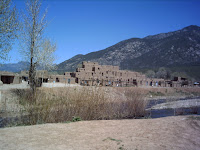
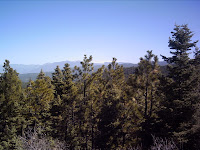
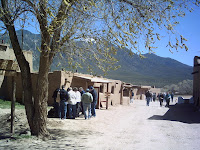 1. View from High Road to Taos 2. Street in the Pueblo 3. Buildings in the Pueblo
1. View from High Road to Taos 2. Street in the Pueblo 3. Buildings in the Pueblo
Some of our group joined a tour led by 'Sunflower' (or was it 'Snowflake'). She told them that the Pueblo has no electricity or running water and is those in it live at a very simple level. Wood in Kiva fire-places are used for heating. Visitors are welcome during work hours, but not allowed into private areas. Those born into the Pueblo belong there and have matrilinear inheritance rights to the buildings. They retain those rights if they choose to live outside the Pueblo. If they marry an Indian of another group, they retain the rights. If they marry a non-Indian they lose them. They are not required to live there and only about 20 people do live the traditional life there. They have their own law and do not pay US Government taxes, hence things we purchase could be cheaper there! They have their own Church and grave-yard and practise both Catholicism and traditonal Indian Religion. They sell crafts to tourists and pueblo breads etc. Here are a few photos you might find of interest:
.JPG)

 1. St Geronimo (Jerome) Church 2. A Craft stall at entrance 3. View over fence into Cemetery
1. St Geronimo (Jerome) Church 2. A Craft stall at entrance 3. View over fence into Cemetery
I bought a few little things there and it was very interesting meeting some of the people who make much of what they sell. Here are a couple:
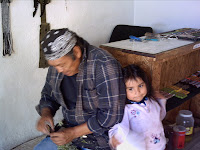
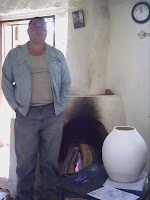
 1. 'Divine Harmony - 2 yrs 6 mths beside her grandfather doing craft. She has an 'abstract' painting, framed, on the wall!
1. 'Divine Harmony - 2 yrs 6 mths beside her grandfather doing craft. She has an 'abstract' painting, framed, on the wall!
2. This stream provides water from melting snow. The young guide, 'Sunflower' is just crossing it.
3. This man was proud to stand beside his Kiva fireplace for a photo. He had his son's school certificates proudly hung on the wall above where he sat.
After our one hour visit, we went down to the Taos square to look around and eat some lunch. It was not very busy but it was hard to find a place to buy something simple like a sandwich and coffee. Some brought their lunch (the wise ones!) and the rest of us fossicked. I settled from two cereal bars I was given plus an apple I brought and some water. I also bought a T-shirt.


 1. A notice about the Plaza
1. A notice about the Plaza 2. These park seats are apparently common in New Mexico; they show the four seasons. There are variations on different seats.
3. Hopefully this map of the Taos district will enlarge if you click on it.
Our next visit was to a bridge over a gorge on the Rio Grande river a few miles outside the town. This was really quite interesting as the gorge, though not quite on Grand Canyon scale, was very impressive. There were also excellent views of the Sangre de Cristo peaks from this location. We drove across the bridge, were dropped off, then walked back to where the vehicles had returned to park. Some with vertigo tendencies did not leave the vehicles!

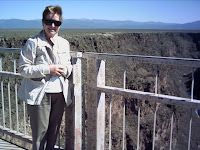
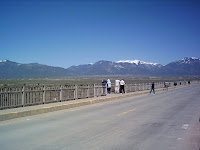 1. Looking east from the bridge
1. Looking east from the bridge
2. Group crossing the bridge - lovely mountains behind.
3. Myself on the bridge.
No day out would be complete without doing some Church visiting! We parked in the grounds of Our Lady of Guadalupe Church in Taos itself, and had a chance to look inside. There is no doubt about the importance of the Our Lady of Guadalupe story in the Church. There are murals, statues and a special shrine all showing various representations of Juan Diego talking to Our Lady or opening up the cloak in which he put the roses and finding the picture of Our Lady of Guadalupe imprinted upon it. I'll show you a selection: 
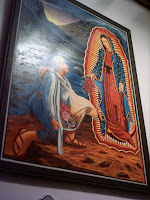
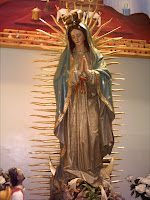 Finally, before heading for home, we called in at a very very old church - San Francisco (St Francis) also in Taos. It wasn't open since we were late (after 4 pm) but the lady who had been there all day showing visitors around, came back specially and opened it for us. No photos are allowed inside the Church, so any taken are outside.
Finally, before heading for home, we called in at a very very old church - San Francisco (St Francis) also in Taos. It wasn't open since we were late (after 4 pm) but the lady who had been there all day showing visitors around, came back specially and opened it for us. No photos are allowed inside the Church, so any taken are outside. 

 1. San Francisco de Asis Church 2. A Gravestone in the courtyard 3. Tulips in flower (back in the Plaza!)
1. San Francisco de Asis Church 2. A Gravestone in the courtyard 3. Tulips in flower (back in the Plaza!)
It has been very enriching during the Sabbatical Course here at Sangre to visit places of great significance. You have yet to see a blog on Pecos - which was a wonderful morning out! To quote from a website about it: "Pecos preserves 12,000 years of history including the ancient pueblo of Pecos, Colonial Missions, Santa Fe Trail sites, 20th century ranch history of Forked Lightning Ranch, and the site of the Civil War Battle of Glorieta Pass."Time is running out here, so I hope I will get time to put some of this on a blog. In the meantime, don't get 'indigestion' ploughing through it all, and I hope the photos do enlarge - at least the left and right ones! Bye for this week. Rita
 Dear All,
Dear All,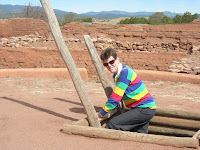
(hopefully you can read it if it enlarges), then there is a photo of the ruins as we saw them, from the same angle. Then, on th right you will see Anne entereing a 'Kiva'. These were sacred rooms accessible only by ladder, circular in shape.